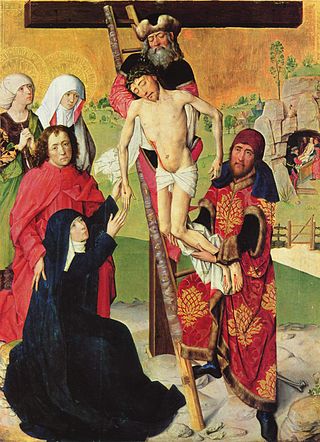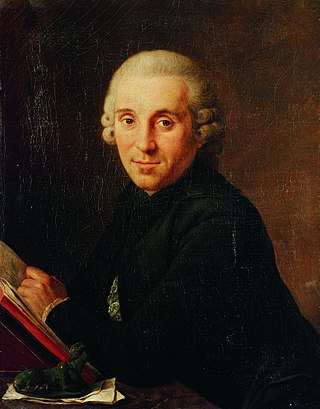
The Wallraf–Richartz Museum is an art museum in Cologne, Germany, with a collection of fine art from the medieval period to the early twentieth century. It is one of the three major museums in Cologne.
Formula composition is a serially derived technique encountered principally in the music of Karlheinz Stockhausen, involving the projection, expansion, and Ausmultiplikation of either a single melody-formula, or a two- or three-voice contrapuntal construction.

The Master of the Life of the Virgin, in German the Meister des Marienlebens,, is the pseudonym given to a late Gothic German painter working in Cologne. He can also be known as the Master of Wilten, or Johann van Duyren, an identification not universally accepted.

The Master of the Saint Bartholomew Altarpiece was an Early Netherlandish painter active in Germany, mostly Cologne, between 1475/1480 and 1510. Despite his anonymity, he is one of the most recognizable artists of the early Renaissance period in German art.

Cologne Charterhouse was a Carthusian monastery or charterhouse established in the Severinsviertel district, in the present Altstadt-Süd, of Cologne, Germany. Founded in 1334, the monastery developed into the largest charterhouse in Germany until it was forcibly dissolved in 1794 by the invading French Revolutionary troops. The building complex was then neglected until World War II, when it was mostly destroyed. The present building complex is very largely a post-war reconstruction. Since 1928, the Carthusian church, dedicated to Saint Barbara, has belonged to the Protestant congregation of Cologne.

Colijn de Coter was an early Netherlandish painter who produced mainly altarpieces. He worked primarily in Brussels and Antwerp. His name was sometimes given as Colijn van Brusele, indicating that he hailed from Brussels or at least that he lived there most of his active life. He also signed several paintings with Coliin de Coter pinxit me in Brabancia Bruselle.

Juno and Argus is a 1610 painting by Peter Paul Rubens, depicting Juno and Argus. It is now in the Wallraf-Richartz Museum in Cologne.

The notname Master of the Aachen Altar is given to an anonymous late gothic painter active in Cologne between 1495 and 1520 or 1480 and 1520, named for his master work, the Aachen Altar triptych owned by the Aachen Cathedral Treasury. Along with the Master of St Severin and the Master of the legend of St. Ursula he is part of a group of painters who were active in Cologne at the beginning of the sixteenth century and were Cologne's last significant practitioners of late gothic painting.

Ferdinand Franz Wallraf was a German botanist, mathematician, theologian, art collector and Roman Catholic priest. His collection formed the founding nucleus of the Wallraf–Richartz Museum.

Johann Anton Alban Ramboux was a German painter and lithographer.

The Master of the Karlsruhe Passion is the notname of a German painter of the late Gothic period active in the Upper Rhine. Very influential on other painters in the region, he may be identified with the Strasbourg painter Hans Hirtz. He is named after his main work, the Karlsruhe Passion, though he may also have been the artist behind the murals in the former Dominican church in Strasbourg, only known through two 17th century copies.

The Master of the Holy Kinship the Younger is a German painter of the Middle Ages who was active between 1475 and 1515 in Cologne and its environs. He is designated "The Younger" to distinguish him from another Master, given the same name, who worked in that area from 1410 to 1440.

St. Kolumba was one of the largest parish churches in medieval Cologne, dating back to 980, and dedicated to Columba of Sens. The original Romanesque church was replaced by a Gothic church. Artworks in it included the Saint Columba Altarpiece by Rogier van der Weyden, and an altar by an anonymous artist.

The Master of the Wasservass Calvary is the notname for a painter active in Cologne between 1415 and 1435. He is relatively unusual in Cologne art of his time, owing more to Burgundian manuscript illuminating and Early Netherlandish painting of the time.

Matthias Joseph de Noël was a German merchant, painter, art collector and writer.

Katja Terlau is a German art historian and provenance researcher. She was a co-initiator and founding member of the international Arbeitskreis Provenienzforschung in Germany, founded in 2000 and is considered a pioneer of German Provenance Research, which she entered after the Washington Principles on Nazi-Confiscated Art of 1998. Her main subject area is looted art; a number of museum holdings and large Jewish collections have been processed by her.

The Master of the Legend of Saint Bruno is the "notname" of an anonymous Gothic painter who was active in Cologne in the late 15th century. He is best known for the cycle of paintings on canvas produced for Cologne Charterhouse after which he is named.

Wilhelm Schreuer was a German painter; associated with the Düsseldorfer Malerschule.

Susanna in the Bath is an early painting by German painter Lovis Corinth, created in 1890 in his hometown of Königsberg. Corinth painted two slightly different versions of it, the first of which he exhibited at the Salon de Paris in 1891. The initial version, believed to be lost, was rediscovered in 2006 through a private auction. The better-known second version, however, has been part of the Museum Folkwang, in Essen, since 1966.
Carl Aldenhoven was a German art historian who served as director of the Ducal Library at the Friedenstein Palace in Gotha (1873–1879), the Ducal Museum in the same city (1879–1890) and the Wallraf-Richartz-Museum in Cologne (1890–1907).




















